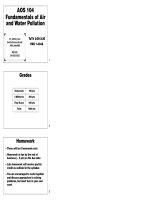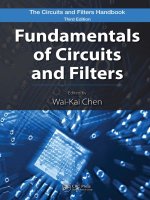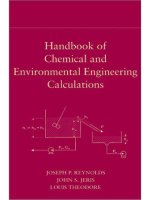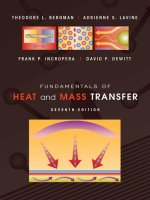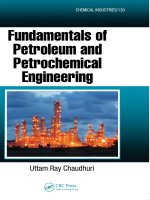fundamentals of petroleum and petrochemical engineering
Bạn đang xem bản rút gọn của tài liệu. Xem và tải ngay bản đầy đủ của tài liệu tại đây (8.01 MB, 406 trang )
K12363_cover 11/15/10 4:30 PM Page 1
C M Y CM MY CY CMY K
Uttam Ray Chaudhuri
Chaudhuri
The supply of petroleum continues to dwindle at an alarming rate, yet it is the
source of a range of products—from gasoline and diesel to plastic, rubber, and
synthetic fiber. Critical to the future of this commodity is that we learn to use it
more judiciously and efficiently. Fundamentals of Petroleum and Petrochemical
Engineering provides a holistic understanding of petroleum and petrochemical
products manufacturing, presented in a step-by-step sequence of the entire supply
chain.
Filled with crucial information relevant to a range of applications, the book
covers topics such as:
• The essential preliminaries for the exploration and production of
crude petroleum oil and gas
• Analysis of crude oil and its petroleum products
• The processing of petroleum in refineries
• The fundamentals of lubricating oil and grease
• Petrochemicals—their raw materials and end products, and
manufacturing principles of industrially important products
• Theories and problems of unit operations and the processes involved
in refineries and petrochemical plants
• Automatic operations in plants
• Start up, shutdown, maintenance, fire, and safety operations
• Commercial and managerial activities necessary for the ultimate
success of a refining or manufacturing business
Due to the advancement of technology, new petrochemicals are being invented
and will continue to be relevant to the petroleum industry in the near future.
Those entering the industry need a firm grasp of the basics as the field
continues to open up new avenues of possibility, while at the same time being
cognizant of the challenges that exist through the heightened focus on
sustainable energy.
Chemical Engineering
K12363
ISBN: 978-1-4398-5160-9
9 78 1439 85 1609
90000
an informa business
6000 Broken Sound Parkway, NW
Suite 300, Boca Raton, FL 33487
270 Madison Avenue
New York, NY 10016
2 Park Square, Milton Park
Abingdon, Oxon OX14 4RN, UK
www.crcpress.com
CHEMICAL INDUSTRIES/130
Fundamentals of Petroleum
and Petrochemical Engineering
Fundamentals of
Petroleum and
Petrochemical
Engineering
Fundamentals of
Petroleum and
Petrochemical
Engineering
CHEMICAL INDUSTRIES
A Series of Reference Books and Textbooks
Founding Editor
HEINZ HEINEMANN
Berkeley, California
Series Editor
JAMES G. SPEIGHT
CD & W, Inc.
Laramie, Wyoming
1. Fluid Catalytic Cracking with Zeolite Catalysts, Paul B. Venuto
and E. Thomas Habib, Jr.
2. Ethylene: Keystone to the Petrochemical Industry, Ludwig Kniel,
Olaf Winter, and Karl Stork
3. The Chemistry and Technology of Petroleum, James G. Speight
4. The Desulfurization of Heavy Oils and Residua, James G. Speight
5. Catalysis of Organic Reactions, edited by William R. Moser
6. Acetylene-Based Chemicals from Coal and Other Natural Resources,
Robert J. Tedeschi
7. Chemically Resistant Masonry, Walter Lee Sheppard, Jr.
8. Compressors and Expanders: Selection and Application for the Process
Industry, Heinz P. Bloch, Joseph A. Cameron, Frank M. Danowski, Jr.,
Ralph James, Jr., Judson S. Swearingen, and Marilyn E. Weightman
9. Metering Pumps: Selection and Application, James P. Poynton
10. Hydrocarbons from Methanol, Clarence D. Chang
11. Form Flotation: Theory and Applications, Ann N. Clarke
and David J. Wilson
12. The Chemistry and Technology of Coal, James G. Speight
13. Pneumatic and Hydraulic Conveying of Solids, O. A. Williams
14. Catalyst Manufacture: Laboratory and Commercial Preparations,
Alvin B. Stiles
15. Characterization of Heterogeneous Catalysts, edited by Francis Delannay
16. BASIC Programs for Chemical Engineering Design, James H. Weber
17. Catalyst Poisoning, L. Louis Hegedus and Robert W. McCabe
18. Catalysis of Organic Reactions, edited by John R. Kosak
19. Adsorption Technology: A Step-by-Step Approach to Process Evaluation
and Application, edited by Frank L. Slejko
20. Deactivation and Poisoning of Catalysts, edited by Jacques Oudar
and Henry Wise
21. Catalysis and Surface Science: Developments in Chemicals
from Methanol, Hydrotreating of Hydrocarbons, Catalyst Preparation,
Monomers and Polymers, Photocatalysis and Photovoltaics, edited by
Heinz Heinemann and Gabor A. Somorjai
22. Catalysis of Organic Reactions, edited by Robert L. Augustine
23. Modern Control Techniques for the Processing Industries, T. H. Tsai,
J. W. Lane, and C. S. Lin
24. Temperature-Programmed Reduction for Solid Materials
Characterization, Alan Jones and Brian McNichol
25. Catalytic Cracking: Catalysts, Chemistry, and Kinetics,
Bohdan W. Wojciechowski and Avelino Corma
26. Chemical Reaction and Reactor Engineering, edited by J. J. Carberry
and A. Varma
27. Filtration: Principles and Practices: Second Edition, edited by
Michael J. Matteson and Clyde Orr
28. Corrosion Mechanisms, edited by Florian Mansfeld
29. Catalysis and Surface Properties of Liquid Metals and Alloys,
Yoshisada Ogino
30. Catalyst Deactivation, edited by Eugene E. Petersen and Alexis T. Bell
31. Hydrogen Effects in Catalysis: Fundamentals and Practical Applications,
edited by Zoltán Paál and P. G. Menon
32. Flow Management for Engineers and Scientists,
Nicholas P. Cheremisinoff and Paul N. Cheremisinoff
33. Catalysis of Organic Reactions, edited by Paul N. Rylander,
Harold Greenfield, and Robert L. Augustine
34. Powder and Bulk Solids Handling Processes: Instrumentation
and Control, Koichi Iinoya, Hiroaki Masuda, and Kinnosuke Watanabe
35. Reverse Osmosis Technology: Applications for High-Purity-Water
Production, edited by Bipin S. Parekh
36. Shape Selective Catalysis in Industrial Applications, N. Y. Chen,
William E. Garwood, and Frank G. Dwyer
37. Alpha Olefins Applications Handbook, edited by George R. Lappin
and Joseph L. Sauer
38. Process Modeling and Control in Chemical Industries, edited by
Kaddour Najim
39. Clathrate Hydrates of Natural Gases, E. Dendy Sloan, Jr.
40. Catalysis of Organic Reactions, edited by Dale W. Blackburn
41. Fuel Science and Technology Handbook, edited by James G. Speight
42. Octane-Enhancing Zeolitic FCC Catalysts, Julius Scherzer
43. Oxygen in Catalysis, Adam Bielanski and Jerzy Haber
44. The Chemistry and Technology of Petroleum: Second Edition, Revised
and Expanded, James G. Speight
45. Industrial Drying Equipment: Selection and Application,
C. M. van’t Land
46. Novel Production Methods for Ethylene, Light Hydrocarbons,
and Aromatics, edited by Lyle F. Albright, Billy L. Crynes,
and Siegfried Nowak
47. Catalysis of Organic Reactions, edited by William E. Pascoe
48. Synthetic Lubricants and High-Performance Functional Fluids,
edited by Ronald L. Shubkin
49. Acetic Acid and Its Derivatives, edited by Victor H. Agreda
and Joseph R. Zoeller
50. Properties and Applications of Perovskite-Type Oxides, edited by
L. G. Tejuca and J. L. G. Fierro
51. Computer-Aided Design of Catalysts, edited by E. Robert Becker
and Carmo J. Pereira
52. Models for Thermodynamic and Phase Equilibria Calculations,
edited by Stanley I. Sandler
53. Catalysis of Organic Reactions, edited by John R. Kosak
and Thomas A. Johnson
54. Composition and Analysis of Heavy Petroleum Fractions,
Klaus H. Altgelt and Mieczyslaw M. Boduszynski
55. NMR Techniques in Catalysis, edited by Alexis T. Bell and Alexander Pines
56. Upgrading Petroleum Residues and Heavy Oils, Murray R. Gray
57. Methanol Production and Use, edited by Wu-Hsun Cheng
and Harold H. Kung
58. Catalytic Hydroprocessing of Petroleum and Distillates, edited by
Michael C. Oballah and Stuart S. Shih
59. The Chemistry and Technology of Coal: Second Edition, Revised
and Expanded, James G. Speight
60. Lubricant Base Oil and Wax Processing, Avilino Sequeira, Jr.
61. Catalytic Naphtha Reforming: Science and Technology, edited by
George J. Antos, Abdullah M. Aitani, and José M. Parera
62. Catalysis of Organic Reactions, edited by Mike G. Scaros
and Michael L. Prunier
63. Catalyst Manufacture, Alvin B. Stiles and Theodore A. Koch
64. Handbook of Grignard Reagents, edited by Gary S. Silverman
and Philip E. Rakita
65. Shape Selective Catalysis in Industrial Applications: Second Edition,
Revised and Expanded, N. Y. Chen, William E. Garwood,
and Francis G. Dwyer
66. Hydrocracking Science and Technology, Julius Scherzer and A. J. Gruia
67. Hydrotreating Technology for Pollution Control: Catalysts, Catalysis,
and Processes, edited by Mario L. Occelli and Russell Chianelli
68. Catalysis of Organic Reactions, edited by Russell E. Malz, Jr.
69. Synthesis of Porous Materials: Zeolites, Clays, and Nanostructures,
edited by Mario L. Occelli and Henri Kessler
70. Methane and Its Derivatives, Sunggyu Lee
71. Structured Catalysts and Reactors, edited by Andrzej Cybulski
and Jacob A. Moulijn
72. Industrial Gases in Petrochemical Processing, Harold Gunardson
73. Clathrate Hydrates of Natural Gases: Second Edition, Revised
and Expanded, E. Dendy Sloan, Jr.
74. Fluid Cracking Catalysts, edited by Mario L. Occelli and Paul O’Connor
75. Catalysis of Organic Reactions
, edited by Frank E. Herkes
76. The Chemistry and Technology of Petroleum: Third Edition, Revised
and Expanded, James G. Speight
77. Synthetic Lubricants and High-Performance Functional Fluids:
Second Edition, Revised and Expanded, Leslie R. Rudnick
and Ronald L. Shubkin
78. The Desulfurization of Heavy Oils and Residua, Second Edition, Revised
and Expanded, James G. Speight
79. Reaction Kinetics and Reactor Design: Second Edition, Revised
and Expanded, John B. Butt
80. Regulatory Chemicals Handbook, Jennifer M. Spero, Bella Devito,
and Louis Theodore
81. Applied Parameter Estimation for Chemical Engineers, Peter Englezos
and Nicolas Kalogerakis
82. Catalysis of Organic Reactions, edited by Michael E. Ford
83. The Chemical Process Industries Infrastructure: Function and Economics,
James R. Couper, O. Thomas Beasley, and W. Roy Penney
84. Transport Phenomena Fundamentals, Joel L. Plawsky
85. Petroleum Refining Processes, James G. Speight and Baki Özüm
86. Health, Safety, and Accident Management in the Chemical Process
Industries, Ann Marie Flynn and Louis Theodore
87. Plantwide Dynamic Simulators in Chemical Processing and Control,
William L. Luyben
88. Chemical Reactor Design, Peter Harriott
89. Catalysis of Organic Reactions, edited by Dennis G. Morrell
90. Lubricant Additives: Chemistry and Applications, edited by
Leslie R. Rudnick
91. Handbook of Fluidization and Fluid-Particle Systems, edited by
Wen-Ching Yang
92. Conservation Equations and Modeling of Chemical and Biochemical
Processes, Said S. E. H. Elnashaie and Parag Garhyan
93. Batch Fermentation: Modeling, Monitoring, and Control, Ali Çinar,
Gülnur Birol, Satish J. Parulekar, and Cenk Ündey
94. Industrial Solvents Handbook, Second Edition, Nicholas P. Cheremisinoff
95. Petroleum and Gas Field Processing, H. K. Abdel-Aal, Mohamed Aggour,
and M. Fahim
96. Chemical Process Engineering: Design and Economics, Harry Silla
97. Process Engineering Economics, James R. Couper
98. Re-Engineering the Chemical Processing Plant: Process Intensification,
edited by Andrzej Stankiewicz and Jacob A. Moulijn
99. Thermodynamic Cycles: Computer-Aided Design and Optimization,
Chih Wu
100. Catalytic Naphtha Reforming: Second Edition, Revised and Expanded,
edited by George T. Antos and Abdullah M. Aitani
101. Handbook of MTBE and Other Gasoline Oxygenates, edited by
S. Halim Hamid and Mohammad Ashraf Ali
102. Industrial Chemical Cresols and Downstream Derivatives,
Asim Kumar Mukhopadhyay
103. Polymer Processing Instabilities: Control and Understanding,
edited by Savvas Hatzikiriakos and Kalman B. Migler
104. Catalysis of Organic Reactions, John Sowa
105. Gasification Technologies: A Primer for Engineers and Scientists,
edited by John Rezaiyan and Nicholas P. Cheremisinoff
106. Batch Processes, edited by Ekaterini Korovessi and Andreas A. Linninger
107. Introduction to Process Control, Jose A. Romagnoli
and Ahmet Palazoglu
108. Metal Oxides: Chemistry and Applications, edited by J. L. G. Fierro
109. Molecular Modeling in Heavy Hydrocarbon Conversions,
Michael T. Klein, Ralph J. Bertolacini, Linda J. Broadbelt, Ankush Kumar
and Gang Hou
110 . Structured Catalysts and Reactors, Second Edition, edited by
Andrzej Cybulski and Jacob A. Moulijn
111. Synthetics, Mineral Oils, and Bio-Based Lubricants: Chemistry
and Technology, edited by Leslie R. Rudnick
11 2. Alcoholic Fuels, edited by Shelley Minteer
11 3. Bubbles, Drops, and Particles in Non-Newtonian Fluids, Second Edition,
R. P. Chhabra
114. The Chemistry and Technology of Petroleum, Fourth Edition,
James G. Speight
11 5. Catalysis of Organic Reactions, edited by Stephen R. Schmidt
11 6. Process Chemistry of Lubricant Base Stocks, Thomas R. Lynch
11 7. Hydroprocessing of Heavy Oils and Residua, edited by
James G. Speight and Jorge Ancheyta
11 8. Chemical Process Performance Evaluation, Ali Cinar, Ahmet Palazoglu,
and Ferhan Kayihan
119 . Clathrate Hydrates of Natural Gases, Third Edition, E. Dendy Sloan
and Carolyn Koh
120. Interfacial Properties of Petroleum Products, Lilianna Z. Pillon
121. Process Chemistry of Petroleum Macromolecules, Irwin A. Wiehe
122. The Scientist or Engineer as an Expert Witness, James G. Speight
123. Catalysis of Organic Reactions, edited by Michael L. Prunier
124. Lubricant Additives: Chemistry and Applications, Second Edition,
edited by Leslie R. Rudnick
125. Chemical Reaction Engineering and Reactor Technology,
Tapio O. Salmi, Jyri-Pekka Mikkola, and Johan P. Warna
126. Asphaltenes: Chemical Transformation during Hydroprocessing of Heavy
Oils, Jorge Ancheyta, Fernando Trejo, and Mohan Singh Rana
127. Transport Phenomena Fundamentals, Second Edition, Joel Plawsky
128. Advances in Fischer-Tropsch Synthesis, Catalysts, and Catalysis,
edited by Burton H. Davis and Mario L. Occelli
129. Advances in Fluid Catalytic Cracking: Testing, Characterization,
and Environmental Regulations, edited by Mario L. Occelli
130. Fundamentals of Petroleum and Petrochemical Engineering,
Uttam Ray Chaudhuri
Uttam Ray Chaudhuri
University of Calcutta
Calcutta, India
Fundamentals of
Petroleum and
Petrochemical
Engineering
CRC Press is an imprint of the
Taylor & Francis Group, an informa business
Boca Raton London New York
CRC Press
Taylor & Francis Group
6000 Broken Sound Parkway NW, Suite 300
Boca Raton, FL 33487-2742
© 2011 by Taylor and Francis Group, LLC
CRC Press is an imprint of Taylor & Francis Group, an Informa business
No claim to original U.S. Government works
Printed in the United States of America on acid-free paper
10 9 8 7 6 5 4 3 2 1
International Standard Book Number: 978-1-4398-5160-9 (Hardback)
This book contains information obtained from authentic and highly regarded sources. Reasonable efforts
have been made to publish reliable data and information, but the author and publisher cannot assume
responsibility for the validity of all materials or the consequences of their use. The authors and publishers
have attempted to trace the copyright holders of all material reproduced in this publication and apologize to
copyright holders if permission to publish in this form has not been obtained. If any copyright material has
not been acknowledged please write and let us know so we may rectify in any future reprint.
Except as permitted under U.S. Copyright Law, no part of this book may be reprinted, reproduced, transmit-
ted, or utilized in any form by any electronic, mechanical, or other means, now known or hereafter invented,
including photocopying, microfilming, and recording, or in any information storage or retrieval system,
without written permission from the publishers.
For permission to photocopy or use material electronically from this work, please access www.copyright.
com ( or contact the Copyright Clearance Center, Inc. (CCC), 222 Rosewood
Drive, Danvers, MA 01923, 978-750-8400. CCC is a not-for-profit organization that provides licenses and
registration for a variety of users. For organizations that have been granted a photocopy license by the CCC,
a separate system of payment has been arranged.
Trademark Notice: Product or corporate names may be trademarks or registered trademarks, and are used
only for identification and explanation without intent to infringe.
Library of Congress Cataloging-in-Publication Data
Chaudhuri, Uttam Ray.
Fundamentals of petroleum and petrochemical engineering / Uttam Ray Chaudhuri.
p. cm. (Chemical industries ; 130)
Includes bibliographical references and index.
ISBN 978-1-4398-5160-9 (hardback)
1. Petroleum engineering. I. Title.
TN870.C5117 2010
665.5 dc22 2010032407
Visit the Taylor & Francis Web site at
and the CRC Press Web site at
Dedication
This book is dedicated to the memory of my parents
Inspired by wife Sampa, daughter Aratrika, and brother Utpal
xi
Contents
Preface xxi
Author xxiii
Introduction xxv
Chapter 1 Crude Petroleum Oil 1
1.1 Composition of Crude Oil 1
1.1.1 Hydrocarbon Groups 1
1.1.1.1 Complex Hydrocarbons 3
1.1.1.2 Non-Hydrocarbons or Hetero-Atomic
Compounds 4
1.2 Physical Properties of Crude Oil 6
1.3 Origin of Hydrocarbons 7
1.4 Exploration Techniques 9
1.4.1 Gravimetric Method 9
1.4.2 Magnetometric Method 10
1.4.3 Seismic Survey 10
1.4.4 Remote Sensing Method 10
1.4.5 Geochemical Methods 11
1.4.6 Stratigraphy 11
1.5 Resource Estimation 11
1.5.1 Effect of Pressure 12
1.5.2 Connate Water 13
1.5.3 Effect of Temperature 13
1.5.4 Effect of Viscosity 13
1.6 Oil Field Development 14
1.7 Well Logging 16
1.8 Oil Production Processes 16
1.9 Crude Conditioning and Storage 19
1.10 Transportation and Metering of Crude Oil 20
1.11 Gas Hydrates 21
1.11.1 Production Method 22
1.12 Coal Bed Methane 22
Questions 23
Chapter 2 Petroleum Products and Test Methods 25
2.1 Crude Oil Analysis 25
2.1.1 API Gravity 27
2.1.2 Characterisation Factor 27
2.1.3 Bottom Sediment and Water 28
xii Contents
2.2 Domestic Fuels 28
2.2.1 Liqui ed Petroleum Gas 28
2.2.2 Kerosene 30
2.2.2.1 Smoke Point 30
2.2.2.2 Flash Point 31
2.2.2.3 Char Point and Bloom 31
2.2.2.4 Distillation Test 32
2.2.2.5 Sulfur Content and Corrosion 32
2.3 Automotive Fuels 32
2.3.1 Motor Spirit 32
2.3.1.1 American Standard for Testing
Material Distillation 33
2.3.1.2 Octane Number 34
2.3.1.3 Corrosion 35
2.3.1.4 Reid Vapour Pressure 36
2.3.1.5 Oxidation Stability 36
2.3.1.6 Additives 36
2.3.2 High Speed Diesel 36
2.3.2.1 Cetane Number 37
2.3.2.2 Diesel Index 37
2.3.2.3 Sulfur 38
2.3.2.4 Corrosion 38
2.3.2.5 Flash Point 38
2.3.2.6 Flame Length 38
2.3.2.7 Pour Point 38
2.3.2.8 Viscosity 38
2.4 Aviation Fuels 39
2.5 Furnace Fuels 39
2.5.1 Gaseous Fuels 39
2.5.2 Liquid Fuels 40
2.6 Lubricating Oils 40
2.6.1 Viscosity 41
2.6.2 Saybolt Method 41
2.6.3 Redwood Method 41
2.6.4 Brook eld Method 42
2.6.5 Viscosity Index 42
2.6.6 Cloud Point 43
2.6.7 Pour Point 43
2.7 Miscellaneous Products 44
2.7.1 Jute Batching Oil 44
2.7.2 Mineral Turpentine Oil 44
2.7.3 Carbon Black Feed Stock 46
2.7.4 Bitumen 46
2.7.5 Petroleum Coke 47
2.7.6 Wax 48
Questions 48
Contents xiii
Chapter 3 Processing Operations in a Petroleum Re nery 49
3.1 Crude Oil Receiving 49
3.2 Desalting of Crude Oil 49
3.3 Distillation and Stripping 51
3.3.1 Atmospheric Distillation 52
3.4 Stabilisation 54
3.5 Amine Absorption 55
3.6 De-Ethaniser 55
3.7 Meroxing and Caustic Wash 56
3.8 Liqui ed Petroleum Gas Splitter 58
3.9 Naphtha Redistillation 58
3.10 Naphtha Pretreatment 59
3.11 Naphtha Platinum Reforming (Platforming) 60
3.12 Kerosene Hydrodesulfurisation 62
3.13 Diesel Hydrodesulfurisation 63
3.14 Vacuum Distillation 64
3.15 Solvent Extraction 66
3.16 Propane Deasphalting 67
3.17 Solvent Dewaxing 67
3.18 Hydro nishing 69
3.19 Catalytic Processes for Lube Oil Base Stock Manufacture 70
3.20 Hydrocracking 71
3.21 Mild Hydrocracking 73
3.22 Hydrogen Generation 74
3.22.1 Feed Desulfurisation 74
3.22.2 Primary Reforming 74
3.22.3 Secondary Reforming 75
3.22.4 Shift Reactors 75
3.22.5 Hydrogen Puri cation 76
3.23 Fluid Catalytic Cracking 76
3.24 Bitumen Blowing 79
3.25 Vis-Breaking 79
3.26 Coking 80
Questions 81
Chapter 4 Lubricating Oil and Grease 83
4.1 Components of Finished Lubricating Oils 83
4.2 Automotive Oils 84
4.3 Industrial Lubricants 85
4.3.1 Bearing Lubricants 85
4.3.2 Hydraulic Lubricants 86
4.3.3 Compressor Lubricants 86
4.3.4 Pump Lubricants 86
4.4 Aviation Lubricants 87
xiv Contents
4.5 Marine Lubricants 88
4.6 Greases 88
4.7 Lube Blending and Grease Manufacture 89
4.8 Environmental Impact of Lubricants 90
4.9 Reclamation of Used Lubricants 92
4.10 Power Consumption in a Blending Tank 94
Questions 98
Chapter 5 Petrochemicals 101
5.1 De ntions of Petrochemicals 101
5.1.1 Feedstocks 101
5.1.2 Intermediates 101
5.1.3 Finished Products 102
5.2 Naphtha Cracking 103
5.2.1 Primary Fractionator or Stabiliser 105
5.2.2 Hydrogen Separator 105
5.3 Conversion Processes for Selected Petrochemicals 107
5.3.1 Polyethylene 107
5.3.1.1 Low Density Polyethylene 108
5.3.1.2 High Density Polyethylene 109
5.3.1.3 Linear Low Density Polyethylene 110
5.3.2 Polypropylene 111
5.3.3 Polyethylene Terephthalate 111
5.3.3.1 Terephthalic Acid 112
5.3.3.2 Ethylene Glycol 113
5.3.4 Polyvinyl Chloride 115
5.3.5 Polystyrene 115
5.3.6 Polybutadiene 116
5.3.7 Acrylonitrile Butadiene Styrene 116
5.3.8 Styrene–Butadiene Rubber 116
5.3.9 Poly Methyl Metha Acrylate 117
5.3.10 Polytetra uoroethylene 117
5.3.11 Nylons 117
5.3.12 Phenol Formaldehyde 120
5.3.13 Urea Formaldehyde 120
5.3.14 Melamine Formaldehyde 120
5.3.15 Polyurethane 121
5.3.15.1 Toluene Diisocyanate 121
5.3.16 Silicone 122
5.4 Petrochemical Complex 122
5.4.1 Downstream Units 122
5.4.2 Petrochemicals’ Hub 122
5.5 Processing of Plastic, Rubber, and Fibre 123
5.5.1 Moulding of Plastics 124
5.5.2 Extrusion Moulding 124
Contents xv
5.5.3 Blow Moulding 126
5.5.4 Compression Moulding 126
5.5.5 Thermal Moulding 126
5.5.6 Injection Moulding 126
5.5.7 Rubber Compounding 127
Questions 128
Chapter 6 Offsite Facilities, Power and Utilities 131
6.1 Layout of Petroleum and Petrochemical Plants 131
6.2 Processing Units 131
6.3 Offsite Facilities 134
6.3.1 Floating Roof Tank 134
6.3.2 Fixed Roof Tank 135
6.3.3 Pressure Vessels 136
6.3.4 Horton Sphere 136
6.3.5 Accessories 136
6.3.6 Blending Operations 139
6.3.7 Filling, Loading, and Despatch Operations 139
6.3.8 Pipeline Transport 139
6.3.9 Ef uent Water Treatment 140
6.3.10 Off Gas Treatment 141
6.3.11 Internal Fuel Oil Circulation 144
6.4 Power and Steam Generating Plant 144
6.5 Cooling Tower 147
6.6 Water Conditioning Plant 147
Questions 150
Chapter 7 Material and Energy Balances 151
7.1 Measurement of Quantity of Crude Oil and Products 151
7.1.1 Tank Dipping 151
7.1.2 Volume Correction 153
7.1.3 Density Correction 153
7.2 Measurement of Gases in Closed Vessels 158
7.3 Material Balance in a Plant 158
7.3.1 Flow Meter Readings 160
7.3.2 Fuel Consumption 161
7.3.3 Steam Consumption 161
7.3.4 Overall Material Balance 161
7.4 Energy Balance in a Plant 164
7.4.1 Heat Balance 164
7.4.2 Energy Balance in a Heat Exchanger 164
7.4.3 Energy Balance in a Furnace 165
7.4.4 Energy Balance in a Distillation Column 166
7.4.5 Overall Energy Balance 168
Questions 170
xvi Contents
Chapter 8 Heat Exchangers and Pipe-Still Furnaces 171
8.1 Heat Exchangers 171
8.2 Theory of Heat Exchange 171
8.2.1 Heat Balance 173
8.2.2 Rate of Heat Transfer 174
8.3 Fouling 177
8.4 Plate Type Heat Exchanger 185
8.5 Extended Surface Exchanger 185
8.6 Scraped Surface Exchanger 185
8.7 Heat Exchanger Train 186
8.8 Pipe-Still Furnace 188
8.9 Pipe-Still Furnace Elements 190
8.9.1 Heater Pipes or Tubes 190
8.9.2 Refractories 191
8.9.3 Burners 191
8.9.4 Convection Zone 192
8.9.5 Radiant Section 192
8.9.6 Stack or Chimney 193
8.10 Operation of a Furnace 193
8.11 Draught in a Furnace 194
8.12 Furnace Design by the Wilson, Lobo and Hottel Method 194
8.12.1 Furnace Design by the Lobo and Evans Method 205
Questions 206
Chapter 9 Distillation and Stripping 207
9.1 Processes of Distillation and Stripping 207
9.2 Batch Distillation 207
9.3 Boiling Point and Equilibrium Diagrams 208
9.4 Theory of Distillation 208
9.5 Continuous Distillation 210
9.5.1 Top Re ux Drum 211
9.5.2 Recti cation Section 212
9.5.2.1 Streams Leaving the Envelope under
Study 212
9.5.2.2 Streams Entering the Envelope under
Study 212
9.5.2.3 Reboiler 213
9.5.2.4 Stripping Section 213
9.5.2.5 Feed Plate or Flash Zone 214
9.5.2.6 Evaluation of Fraction Vaporised (f)
from the Quality of the Feed 215
9.6 McCabe–Thiele Method 217
9.6.1 Operating Line for the Feed Section or Feed Line 218
9.6.2 Operating Line and Plates for the Stripping Section 218
Contents xvii
9.7 Enthalpy Balance Method 219
9.7.1 Re ux Drum 219
9.7.2 Top Plate 220
9.7.3 Reboiler 221
9.7.4 Numerical Solution 223
9.7.5 Types of Re uxes 229
9.7.6 Internal Re ux 230
9.7.7 Minimum Re ux 230
9.8 Gap and Overlap 230
9.9 Packie’s Correlation 231
Question 234
Chapter 10 Extraction 235
10.1 Extraction Principle 235
10.2 Extraction Process 236
10.3 De nition of Terms Related to Extraction 236
10.3.1 Partition Coef cient 236
10.3.2 Partial Solubility 237
10.3.3 Solvent to Feed Ratio 237
10.3.4 Solvent Recovery 237
10.3.5 Separation of Phases 237
10.3.6 Selectivity 237
10.3.7 Solvent Power 238
10.3.8 Critical Solution Temperature 238
10.4 Phase Equilibrium in the Extraction Process 238
10.5 Batch Extraction 239
10.6 Continuous Extraction 240
10.6.1 Computation of Number of Plates 240
Questions 248
Chapter 11 Reactor Calculations 249
11.1 Reactors in Re neries and Petrochemical Plants 249
11.2 Reaction Stoichiometry, Mechanism, and Pathways 249
11.3 Rate of Reaction and Kinetic Equations 250
11.4 Batch, Continuous Stirred Tank Reactor, and Plug Flow
Reactor Concepts 252
11.5 Naphtha Reformer Calculations 269
11.6 Calculations for a Fluidised Catalytic Cracking Reactor 271
Chapter 12 Elements of Pipeline Transfer Facilities 275
12.1 Pipes and Tubes 275
12.2 Fittings and Supports 275
12.2.1 Corrosion Protection 276
xviii Contents
12.3 Crude Oil Transfer Lines 277
12.3.1 Design Steps for Crude Pipes 277
12.3.2 Economic Pipe Diameter 279
12.4 Product Transfer Lines 279
12.5 Gas Transfer Lines 280
12.6 Pumps and Compressors 281
12.6.1 Centrifugal Pumps 281
12.6.1.1 Priming 283
12.6.1.2 Speci c Speed 285
12.6.2 Positive Displacement Pumps 287
12.6.3 Rotary Pumps 288
12.6.4 Compressors 289
12.7 Power Calculations for Pumping and Compression 290
Chapter 13 Instrumentation and Control in a Re nery 297
13.1 Control Hardware 297
13.1.1 Hardware 297
13.1.2 Cables 298
13.2 Control Loops 299
13.3 The Process Piping and Instrumentation Diagram 301
13.4 Control Software 301
13.5 Distributed Control System 304
13.6 The Control Room 305
13.7 Crude Throughput Control 305
13.8 Desalter Control 306
13.9 Atmospheric Distillation Column Control 308
13.9.1 Re ux Drum Pressure Control 308
13.9.2 Re ux Drum Level Control 308
13.9.3 Top Plate Temperature 310
13.9.4 Draw Plate Temperature 310
13.9.5 Over ash Rate 312
13.9.6 Flash Zone Pressure and Temperature 312
13.9.7 Bottom Temperature 312
13.9.8 Furnace Control 312
13.10 Vacuum Distillation Control 312
13.11 Reformer Unit Control 314
13.12 Fluid Catalytic Cracking Unit Control 314
13.12.1 Reactor Outlet Temperature Control 316
13.12.2 Level Control of the Catalyst Bed in the Stripper
Section of the Reactor 319
13.12.3 Pressure Balance between the Reactor and the
Regenerator 319
13.13 Fail-Safe Devices 319
13.13.1 Normal Running Conditions 319
13.13.2 During Planned Shutdown 321
Contents xix
13.13.3 During Accidents or Emergency Shutdown 322
13.13.4 Power Plant Failure 323
13.14 Standard Signals in Process Control 323
Chapter 14 Miscellane ous 325
14.1 Startup 325
14.1.1 Power Plant Startup 325
14.1.2 Startup of a Crude Distillation Unit 326
14.1.3 Starting a Naphtha Pretreatment Plant 327
14.1.4 Starting a Naphtha Reforming Plant 328
14.1.5 Starting a Fluid Catalytic Cracking Plant 328
14.2 Shutdown 329
14.2.1 Shutdown of a Crude Distillation Unit 330
14.2.2 Shutdown of a Naphtha Pretreatment Unit 330
14.2.3 Regeneration of the Catalyst 330
14.2.4 Shutdown of a Naphtha Reforming Unit 331
14.2.5 Regeneration of Reforming Catalyst 331
14.3 Maintenance of Plant and Equipments 332
14.4 Fire and Explosion 333
14.4.1 Pyrophoric Iron 334
14.5 Factories Act 335
14.6 Safety Analysis 337
Chapter 15 Plant Management and Economics 343
15.1 Cost of Equipment 343
15.1.1 Capacity Ratio Method 343
15.1.2 Purchased Price 344
15.1.3 First Cost of the Equipment 344
15.1.4 Depreciation 344
15.2 Cost of a Plant 344
15.3 Operating Cost 344
15.4 Product Cost 344
15.5 Pro t and Product Price 345
15.6 Taxes and Duties 345
15.7 Breakeven Point, Payout Period, and Rate of Return 345
15.7.1 Payout Period or Payback Period 346
15.7.2 Rate of Return 346
15.8 Linear Programming 349
15.9 Material Audit 352
15.9.1 Category of Materials 352
15.9.2 Papers to Be Maintained 353
15.9.2.1 Tank Dip Register 353
15.9.2.2 Pass Out Vouchers 353
15.9.2.3 Tank Dip Memos 353
xx Contents
15.9.2.4 Daily Stock Report 355
15.9.2.5 Daily Pumping Record 355
15.9.2.6 Daily Operation Record 355
15.9.3 Material Audit of Capital Goods 366
15.10 Energy Audit 367
15.10.1 Electricity Audit 367
15.10.2 Thermal Audit 368
15.10.3 Steam Balance 368
Appendix 375
Index 381
xxi
Preface
Modern civilisation cannot think of a day without petroleum and petrochemicals.
Petroleum fuels, such a gasoline and diesel, are the major fuels for all transportation
vehicles. Commodities manufactured from petrochemicals, for example, plastics,
rubbers and synthetic bres derived from petroleum, have become part and parcel of
our daily life. The absence of petroleum will cause an end to our modern civilization
unless alternative means are available. In fact, petroleum is a non-renewable fossil-
ised mass, the amount of which is being exhausted with our increasing consumption.
Future crude oil will be heavier and contaminated with unwanted salts and metals.
Production and processing will be costlier than ever before. Therefore, it is inevitable
to make use of this dwindling natural resource more judiciously and ef ciently for
the sustenance of our civilisation. The contents of this book have been prepared to
provide a holistic working knowledge about petroleum and petrochemical technol-
ogy. Chapter 1 presents the essential preliminaries for the exploration and production
of crude petroleum oil and gas. This chapter is an introduction for beginners who
may be entering the profession of oil and gas exploration and production. Chapter 2
is an analysis of crude oil and petroleum products. This will help scientists entering
the profession as chemists in a re nery. The processing of petroleum in re neries is
discussed in Chapter 3 and may be useful for apprentice engineers in a re nery. The
fundamentals of lubricating oil and grease are dealt with in Chapter 4, which is use-
ful for engineers and scientists entering the lubricants industries. Chapter 5 discusses
the fundamentals of petrochemicals, their raw materials, and the end products, along
with the manufacturing principles of some of the industrially important products.
This chapter may be important for the engineer who is likely to follow a profession
in petrochemical plants. The rest of the book, from Chapters 6 through 15, will be of
common interest to engineers in re neries and petrochemical plants. Chapters 6 to
12 deal with the theories and problems of unit operations and the processes involved
in re neries and petrochemical plants. The essential knowledge of automatic opera-
tions in a plant is dealt with in Chapter 13. Without this knowledge, engineers will
not be successful in operating any plant. Chapter 14 deals with various miscella-
neous activities, like start up, shutdown, maintenance, re, and safety operations,
which are essential to the running of any plant. Chapter 15 discusses the commercial
and managerial activities that any engineer has to know for the ultimate success of
re ning or manufacturing businesses.
xxiii
Author
Uttam Ray Chaudhuri is an associate professor in the Department of Chemical
Technology, University of Calcutta. He holds a PhD in chemical engineering from
the Indian Institute of Technology, Kharagpur, India. He received his graduate and
postgraduate degrees in chemical engineering from Jadavpur University. He has 30
years of experience in industry, research, and teaching in the eld of chemical engi-
neering and technology. He has a number of research publications in foreign and
Indian journals to his credit. He also served as a chemical engineer for more than
ten years in the Indian Oil Corporation Ltd. (Re neries and Pipeline Division).


